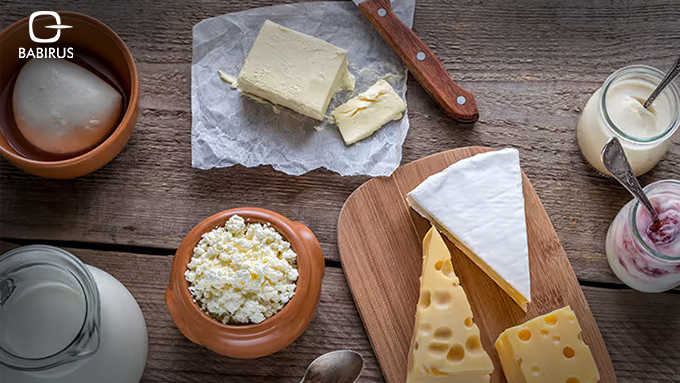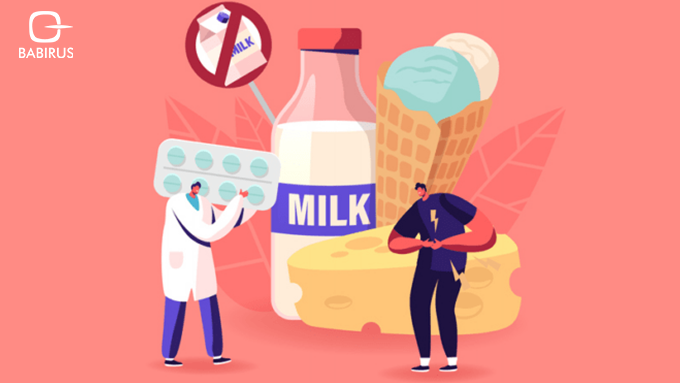What to Eat and Avoid if You Have Lactose Intolerance

Living with lactose intolerance can feel limiting at first, especially if you’ve grown up enjoying milk in your coffee, cheese on your sandwich, or ice cream on a warm day. But the truth is, managing lactose intolerance doesn’t mean giving up on taste or variety. With the right knowledge and simple food swaps, you can enjoy a balanced, satisfying diet and avoid uncomfortable symptoms.
Whether you’ve recently been diagnosed or you’ve been managing it for years, this guide breaks down what to avoid, what you can safely enjoy, and how to take control of your daily meals, especially if you’re navigating this in the UAE, where dietary options are diverse.
What Is Lactose Intolerance
Lactose intolerance is the body’s inability to fully digest lactose, a sugar found in milk and dairy products. This happens when your small intestine doesn’t produce enough lactase, the enzyme needed to break down lactose.
The result? Symptoms such as:
- Bloating
- Gas
- Stomach cramps
- Diarrhea
- Nausea, especially after consuming dairy
It’s important to note that lactose intolerance is not the same as a milk allergy. An allergy involves the immune system and can trigger serious reactions. Lactose intolerance is a digestive issue and often varies in severity.
This condition is particularly common in the Middle East, including the UAE, where a significant portion of the population experiences some level of lactose intolerance.
Foods to Avoid with Lactose Intolerance
Managing your symptoms begins with understanding which foods are likely to cause them. Here are some high-lactose culprits:
Dairy Products High in Lactose:
- Whole, skimmed, or flavored milk
- Soft cheeses like cream cheese, ricotta, and cottage cheese
- Ice cream and frozen yogurt
- Yogurt (unless lactose-free)
- Butter and buttermilk
- Cream (including whipped cream and sour cream)
Even small amounts of these products can trigger symptoms for some people. The severity depends on your individual tolerance level.
Hidden Sources of Lactose
Many processed foods contain lactose as a stabilizer or filler. Always check labels for terms like:
- Milk solids
- Whey
- Curds
- Casein
- Lactose
- Nonfat dry milk powder
Some surprising foods that may contain hidden lactose:
- Breads and baked goods
- Salad dressings
- Instant soups and noodles
- Processed meats like sausages and lunch meats
- Certain chips and crackers
- Chocolate and flavored snacks
In the UAE, imported foods often follow different labeling standards, so double-check when purchasing from international brands.
What You Can Eat Safely
The good news? There’s a long list of delicious, nutritious foods that are naturally lactose-free.
Naturally Lactose-Free Foods:
- Fruits and vegetables
- Grains (rice, oats, quinoa, couscous)
- Legumes (lentils, chickpeas, beans)
- Nuts and seeds
- Meat, fish, poultry, and eggs
- Healthy oils (olive oil, avocado oil)
Plant-Based Dairy Alternatives
Today’s markets, especially in UAE cities like Dubai and Abu Dhabi, are well-stocked with alternatives:
- Plant milks: Almond milk, oat milk, rice milk, soy milk, coconut milk
- Non-dairy yogurt: Coconut yogurt, almond yogurt
- Non-dairy cheese: Made from cashews, soy, or oats
- Lactose-free dairy: Some dairy products are treated with lactase, making them safe for those with intolerance
Look for labels that clearly state “lactose-free,” and avoid those that simply say “non-dairy” unless you’re sure of the ingredients.
Managing Lactose Intolerance Day-to-Day
Managing lactose intolerance is a journey of awareness and adaptation. Here are some proven strategies:
1. Start with Small Amounts
Some people with lactose intolerance can tolerate small portions of dairy without issue. A piece of aged cheese (like parmesan or cheddar) may be fine, while milk might not be. Monitor your body’s response.
2. Use Lactase Supplements
Over-the-counter lactase enzyme tablets can help digest lactose when taken just before eating dairy. They’re especially useful when dining out or attending events.
3. Keep a Food Diary
Tracking what you eat and how you feel can help identify specific triggers. This is especially helpful if you’re also managing food intolerances or IBS.
4. Get to Know Local Cuisine
In the UAE, some traditional dishes use yogurt, cream, or ghee. Be cautious with:
- Kheer (milk-based dessert)
- Laban (fermented milk drink)
- Creamy curries
When eating out, don’t hesitate to ask about dairy content or request substitutions. Many restaurants in Dubai offer vegan or dairy-free menus.
Sample 1-Day Lactose-Free Meal Plan
Managing lactose intolerance doesn’t mean settling for bland meals. With the right substitutions and a bit of planning, you can enjoy satisfying dishes that nourish your body and keep symptoms at bay. Below is a thoughtfully curated, beginner-friendly meal plan using ingredients widely available across the UAE, from supermarket chains like Carrefour to organic shops like Organic Foods & Café.
Breakfast:
Start your day with something hearty and gentle on the gut.
- A warm bowl of oatmeal cooked with unsweetened almond milk
- Topped with chia seeds (for fiber and omega-3s), banana slices, and a sprinkle of cinnamon for natural sweetness
This combo is energy-sustaining and easy to digest, making it ideal for a lactose-free start.
Mid-Morning Snack:
- A small handful of raw almonds paired with a juicy orange
Almonds offer healthy fats and protein, while oranges provide vitamin C, a refreshing duo to power you through the morning.
Lunch:
- Grilled chicken breast, seasoned lightly and served with a fresh quinoa salad
- Salad ingredients: chopped cherry tomatoes, cucumber, parsley, a splash of lemon juice, and a drizzle of extra virgin olive oil
- Side of hummus with carrot sticks or cucumber slices
This Mediterranean-inspired meal is both rich in flavor and free of dairy , an excellent midday option.
Afternoon Snack:
- Coconut-based yogurt (unsweetened if possible) with fresh berries
Coconut yogurt offers a creamy texture without the lactose, and berries add antioxidants and a burst of color.
Dinner:
- Oven-baked salmon fillet, seasoned with herbs and olive oil
- A side of steamed broccoli and roasted sweet potatoes with rosemary
This dinner provides protein, healthy fats, and slow-digesting carbs , a gentle, nutrient-rich way to end the day.
Dessert (Optional):
- Blend one frozen banana with a spoonful of cocoa powder and a splash of almond milk for a naturally sweet, creamy dairy-free “ice cream”
Top with chopped nuts or dark chocolate shavings for extra indulgence.
This plan keeps your meals exciting and gut-friendly while ensuring you get enough protein, fiber, and vitamins. It’s easily adaptable, swap quinoa for brown rice, chicken for tofu, or sweet potato for zucchini, depending on your taste or what’s in your pantry.
When to Seek Professional Advice
Even with careful food choices, some people continue to experience symptoms like gas, bloating, or discomfort that just doesn’t go away. If that sounds familiar, it might not be just lactose intolerance. In fact, symptoms that persist despite eliminating dairy may indicate something deeper going on.
Here are a few conditions that mimic lactose intolerance:
- IBS (Irritable Bowel Syndrome): A common disorder affecting the large intestine. It can be triggered by certain foods, stress, or changes in gut bacteria, and dairy might just be one piece of the puzzle.
- SIBO (Small Intestinal Bacterial Overgrowth): A condition where bacteria overgrow in the small intestine, leading to gas, bloating, and poor nutrient absorption. Many people with SIBO mistakenly think they’re reacting only to dairy.
- Other food intolerances: You might be sensitive to other components like gluten, fructose, or histamine, which can co-exist with lactose intolerance.
When in doubt, seek help from a qualified nutritionist or gastroenterologist. They may recommend further testing such as:
- A FoodPrint test, which identifies IgG reactions to 222 foods, helpful for uncovering non-lactose-related sensitivities
- A SIBO breath test, like the LactoFAN test, which can detect bacterial overgrowth contributing to your symptoms
Understanding what’s really going on inside your gut is key to feeling better. Don’t settle for guesswork when clear answers and tailored solutions are within reach.
Tips for Eating Out in the UAE
Dining out is one of the joys of life in the UAE, where culinary diversity shines through every neighborhood. But for those avoiding dairy, managing restaurant menus can sometimes feel like a minefield. Here’s how to enjoy your favorite spots without second-guessing your meal:
- Choose wisely:
Opt for grilled meats, rice dishes, salads, and broths. Avoid anything creamy, cheesy, or marked as rich. Many Middle Eastern, Asian, and vegan restaurants naturally offer lactose-free options. - Ask questions confidently:
Most chefs and staff in the UAE are familiar with dietary restrictions. Politely ask whether a dish contains cream, milk, cheese, butter, or ghee. Don’t assume , even seemingly clear dishes can contain yogurt or hidden dairy. - Don’t forget sauces and dressings:
Sauces are a common hiding place for cream or cheese. Ask for these on the side, or request olive oil and lemon as a safer alternative. - Check the menu in advance:
Many restaurants in Dubai, Abu Dhabi, and Sharjah offer online menus where allergens are marked. Apps like Zomato, Talabat, or Deliveroo also allow you to filter for vegan or allergen-friendly choices. - Try cuisines that naturally use little to no dairy:
Thai, Japanese, Chinese, Indian (with care), and Lebanese menus often have dairy-free staples like stir-fries, curries with coconut milk, lentil soups, rice bowls, and grilled kebabs. - Always keep a backup:
Carry a small snack like a protein bar or lactose-free trail mix when you’re unsure of your options, especially helpful at buffets or social gatherings.
With a little preparation and open communication, dining out can still be spontaneous, enjoyable, and most importantly safe.
To conclude,
Lactose intolerance is manageable with the right tools and awareness. By understanding what to avoid, discovering great alternatives, and learning how to adapt in different environments like restaurants or family gatherings, you can continue to enjoy a rich and varied diet.
The UAE’s growing awareness around digestive health means more lactose-free products are becoming available every year. From almond milk in your karak chai to coconut-based desserts at your favorite café, options are expanding.
Remember, food should nourish and energize , not hold you back. With a bit of planning and knowledge, you can thrive while living lactose-free.


